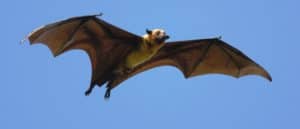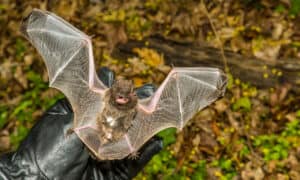Bats, those dark-winged creatures of the night, tend to munch on insects and fruit, as well as nectar and pollen. However, three outlier species of bat make meals of larger creatures. Diaemus youngi, Diphylla ecaudata, and Desmodus rotundus or the white-winged, hairy-legged, and common vampire bat respectively, are known as sanguivores — a category of animal that subsists entirely on blood. Rather than engage in the aerial hunt of a flying insect, or slip an elongated tongue toward the sweet nectar of a pitcher plant, these three vampire bats bite ankles and lap up the resulting blood.
Living off their bloody diet isn’t easy, however. It requires certain adaptations, which a new study has identified in their genome. By comparing the genes of vampire bats against other bat species, researchers uncovered 13 missing genes that allow these sanguivores to break down their all blood diet.
Vampire Bats’ Missing Genes
In order to derive nutrients from blood, there must be specific changes to the way a bat’s digestion and metabolism function compared to most other species of bat. For example, blood carries with it large quantities of iron. Excess iron becomes toxic, damaging the digestive system. One of the thirteen missing genes in vampire bats, known as REP15, retains iron in the gastrointestinal tract. Losing it creates more passages in their GI cells through which iron passes. These cells then get replaced, efficiently disposing of the extra iron.
An additional two missing genes relate to the production of insulin. Insulin secretes from the pancreas to help stabilize sugar levels in the blood. This management shuffles glucose into cells for storage. Bloodsucking bats, it turns out, use only small amounts of insulin. Since blood contains little sugar, they need it readily available in their bloodstream, as opposed to packing it away.
Conversely, vampire bats produce greater quantities of the enzyme trypsin. This enzyme goes to work on protein, helping break down and absorb it into the bat’s system. Since they lack the gene regulating the production of trypsin, vampire bats more easily siphon nutrients from their food.
Interestingly, researchers also found missing genes impacting cognitive abilities. A metabolic substance known as 24S-hydroxycholesterol gets repressed by a gene in other bat species, but not in vampire bats. The proliferation of the metabolite has been shown in other studies to relate to a greater spatial memory in rodents. Researchers believe this may be responsible for these sanguivorous bats’ greater social memory.
Other missing genes relate to taste, showing a lack of sweet and bitter in the bats’ palate.
Study Proves Tricky
Several hurdles present themselves when attempting research of this kind. For one, gene loss doesn’t necessarily mean the gene has been completely removed from the genome. It means a gene has either disappeared or lost its function. This presents difficulty in the research, potentially leading to miscategorized genes with regards to functionality. For example, a previous study concluded that a certain antimicrobial gene was active that this new study determined was inactive.
Researchers hope to hone their methods with future studies. Michael Hiller, a genomicist and co-author of the study, wishes to review duplication of genes, growth of gene families, as well as differences between gene expression. Despite being one of the most studied species, “we still have many gaps in our knowledge,” says Hiller.
They first emerged 26 million years ago. Scientists believe they hunted parasites that alighted on larger creatures. Once landing on the hide of a greater animal to pluck the insect, they likely cut open the flesh and consumed small quantities of blood. Several genetic mutations later, the three sanguivore species cut out the bugs altogether in favor of blood. With such a unique diet, scientists and the public alike have been fascinated by vampire bats, who still offer some mystery for curious researchers.
Up Next
The photo featured at the top of this post is © Ltshears / Creative Commons / Original
Sources
- LiveScience / Accessed October 31, 2021
- The Scientist / Accessed October 31, 2021
- NewScientist / Accessed October 31, 2021
- The Infinite Spider / Accessed October 31, 2021
- PBS / Accessed October 31, 2021
FAQs (Frequently Asked Questions)
What other sanguivore species are there?
Vampire bats aren’t the only creatures to make meals of blood. Many other species feast upon the wounds of their targets. Some are well known, of course. There’s mosquitoes, using needle-like snouts to prick skin and hoover up blood like a milkshake. Other bugs, like ticks and the aptly named vampire moth, also feast on blood, but so do certain bird species. For instance, the oxpecker eats ticks off the backs of rhinos and giraffes, but it specifically targets those that have already gorged themselves on blood. Effectively, that makes the oxpecker a sanguivore, as well.
Another, the vampire finch, lives in the Galapagos and feeds on the blood of other birds. They peck away at the tails or wings of blue footed boobies until they cause bleeding and then drink from the wound. What’s particularly fascinating about this behavior is that the birds they feed on don’t shoe them away. It’s believed that once in their history they provided a service, removing harmful insects from the other birds. Over time, however, in an evolutionary path likely mirroring vampire bats, they transitioned to an all blood diet.
Do vampire bats feed on humans?
Generally, vampire bats do not hunt humans. Contrary to popular media and vampiric lore, they more frequently target birds and livestock. They’ve been observed feasting on an array of animals, though, including porcupines, penguins, snakes, and sea lions, proving they’re not afraid of a little challenge. Vampire bats are capable of feeding on most types of animals, which means humans can fall victim to their bite, it just isn’t common. Usually, in those rare instances, people camp in open ground in a territory known to contain a population of vampire bats.
Thank you for reading! Have some feedback for us? Contact the AZ Animals editorial team.







